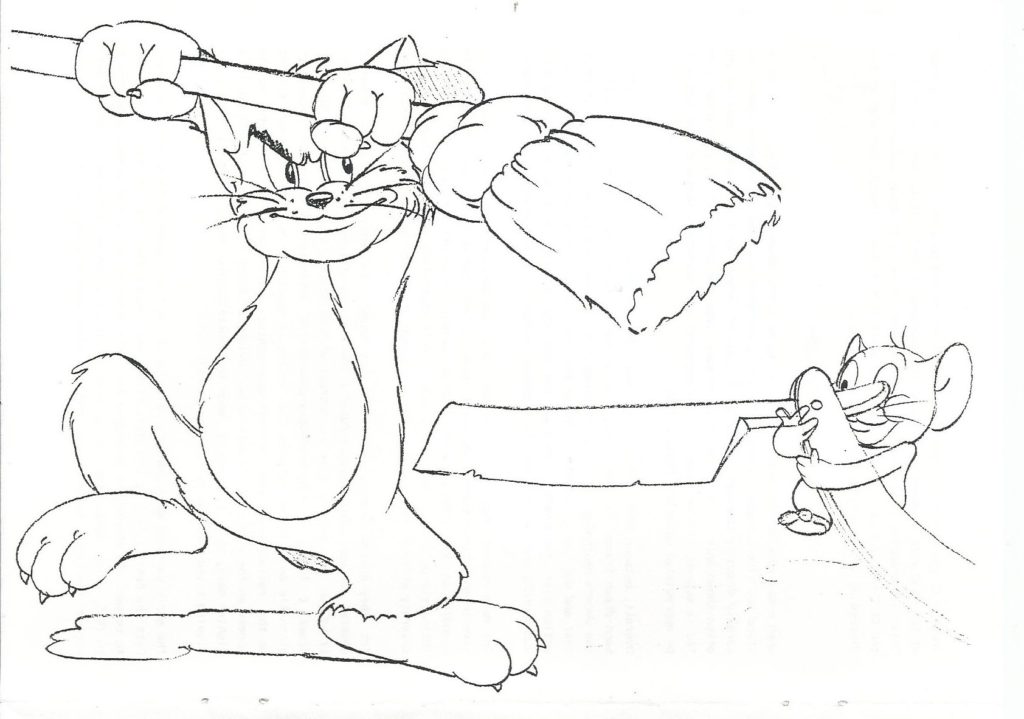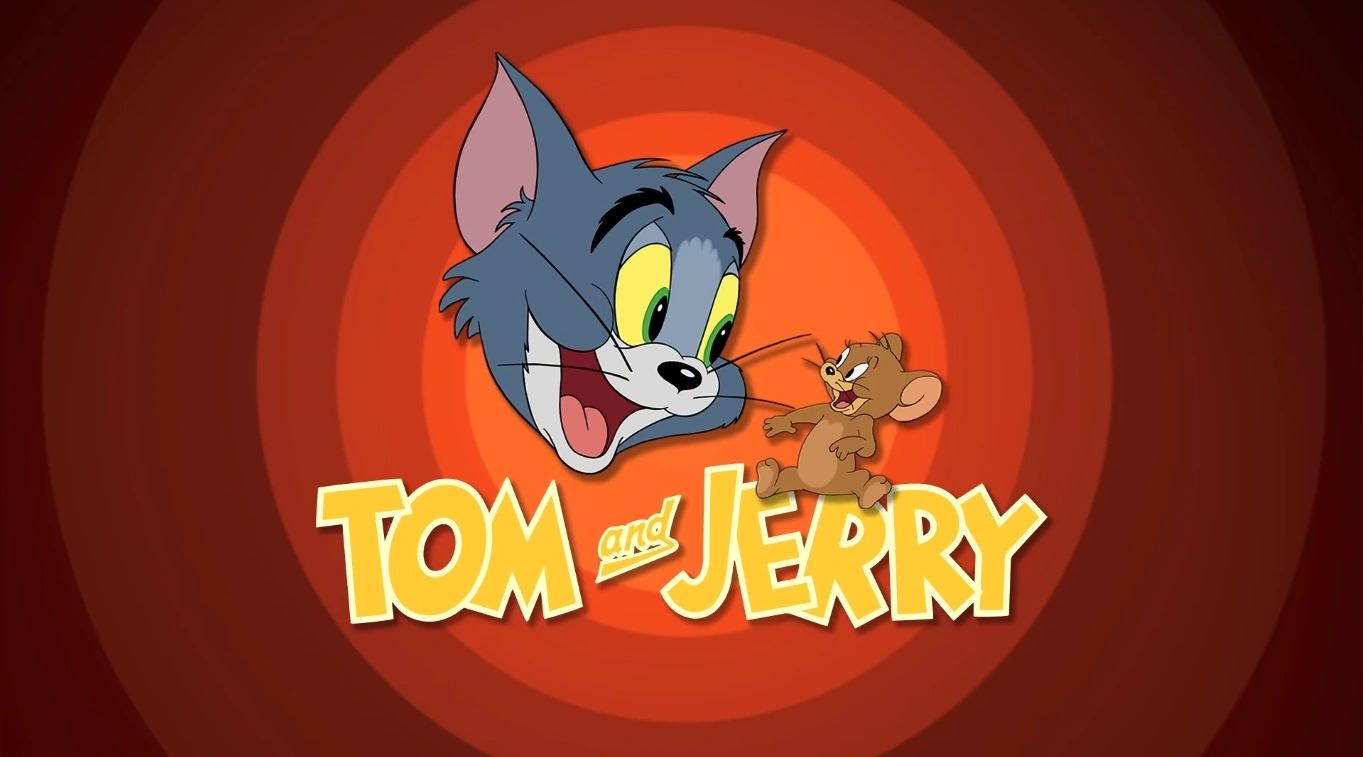Tom & Jerry
Imagine if you will a film where characters are sliced up with wire, hit on the back of the head with a hammer and have nails implanted in their flesh. “Hellraiser”? No. This film predates it by over 40 years, has been shown on TV uncut and was passed by the BBFC with a U certificate. I have to admit it’s a cheat, though. For what we are discussing is not a film, but a cartoon series…
When compared with the appalling animation so often shown on TV today, Tom & Jerry stand out like a nugget of gold. While “Thundercats” and “The Real Ghostbusters” are largely drawn by computer, with the minimum of complexity (characters walking are often shown only from the waist up because legs are ‘difficult’), the drawing in T&J is superb, with no skimping and sequences are frequently included that can only be appreciated using the PAUSE button.
Overall, between 1940 and 1967, MGM made 161 cartoons – that’s about 1.75 million hand-drawn frames. At their best, the animation is well up to Disney standard: in the decade beginning 1943, T&J received Oscar nominations for Best Animation EVERY year and won SEVEN, including FOUR on the trot – a record far in excess of any live-action star. And remember, this was the same era as Warner Bros. were producing Bugs Bunny and Disney weren’t exactly slacking either – further proof of MGM’s strength.
The main element running through nearly all the cartoons is surreal violence. T&J live in an alternate universe, where gravity functions only when you realise you’re standing on air, canaries pull 2000 lb. weights from off-screen and all flesh is infinitely deformable and semi-liquid – both characters often have their topology severely altered through being cut, chopped, broken and burnt beyond recognition.
Yet they always seem to survive. I say ‘seem’, for death is an overt theme in several cartoons. In ‘Heavenly Puss’ (1949), Tom will only be allowed into heaven if he can get Jerry to sign a contract of forgiveness. And, even worse, ‘Blue Cat Blues’ (1956) is a horrendously pessimistic love-story in which Tom becomes an alcoholic and attempts suicide. The ending is equally grim, both characters sitting on the railway track with a train approaching. Not often shown on TV and yet to appear on the videos, it is conclusive evidence T&J is not a kiddies’ cartoon. On a lighter note, this can also be seen in ‘Yankee Doodle Mouse’ (1943), where the closing scene asks you to ‘Buy War Bonds’.
The early cartoons seem quaintly naive, with Tom (or Jasper as he’s called in ‘Puss Gets The Boot’ (1940), the first film) not looking much like the suave cat he was to become. The characters developed over the years up until Fred Quimby’s departure in 1955, which marked the end of what is almost universally thought of as the best period; the cracks began to show and the ideas were starting to run out. “Life With Tom” (1953) is just an excuse to clip together bits from three old cartoons and “The Egg & Jerry” (1956) is a pure remake, virtually frame for frame, of the earlier “Hatch Up Your Troubles”.

Therefore, it wasn’t so great a surprise when the series was eventually cancelled in 1958. However, three years later T&J made a comeback under the guiding hand of Chuck Jones. The changing economics of animation forced modifications in the style – the backgrounds are no longer as detailed as they were – and the content, with human characters being introduced; in previous cartoons only people’s legs had ever been seen. These cartoons, though quirky and amusing in their own right, take the cat & mouse struggle out of the arena of the home far more often than previously and are often highly derivative. To be fair, some are very funny – ‘Bad Day at Cat Rock’ (1965) is lovely visual humour, even if it is more than a little like Wile E. Coyote v. Roadrunner, which Jones did a lot of for Warner Bros. The end has virtually all the combinations possible of a cat, a see-saw and a building site…
1967 saw the final T&J film, ‘Purr-chance to Dream’ (totally ignoring Hannah- Barbera’s TV massacre of them in the 70’s), yet the BBC’s sterling use has helped ensure that generations not born when the cartoons were made have grown up knowing and loving them. A whole industry of annuals, soft toys, clothing and comics has been sustained by them – I recall having every issue of ‘Tom and Jerry Weekly’ and imagine they’d be worth a fair bit now had I kept them!
Although the main struggle throughout is Cat vs. Mouse, other combinations are often seen. Cat against two mice, cat against dog and mouse, cat and mouse against cat or dog or robot. Yet conflict is not a vital component. The classic ‘The Night Before Christmas’ (1941) has more real Yuletide spirit in each second of it’s nine minutes than an entire Russ Abbott Christmas Special. ‘Mouse in Manhattan’ (1943) is also non-violent, showing Jerry’s adventures in the Big Apple – Tom only appears in the final few seconds of this one.
Tom and Jerry’s humour is timeless and international, thanks to it’s visual style and lack of any significant dialogue, compared to Bugs Bunny, for example. France has gone for them in a big way, thanks mainly to the efforts of Patrick Brion, whose mammoth tome ‘Tom et Jerry’ remains THE work on the subject, lavishly illustrated but hideously expensive, it’s forty pound price tag putting it out of reach of all save the rabid, hard-core fan. However, six videos of the duo are now available for under a tenner and any one of these will give you hours of entertainment.
To sum up, Tom & Jerry are essentially a distillation of all violent humour from The Three Stooges through to Sam Raimi, and prove again that fictional nastiness has no effect on the individual. Perhaps, after all, the difference between them and “Hellraiser” wasn’t quite as wide as we thought…
